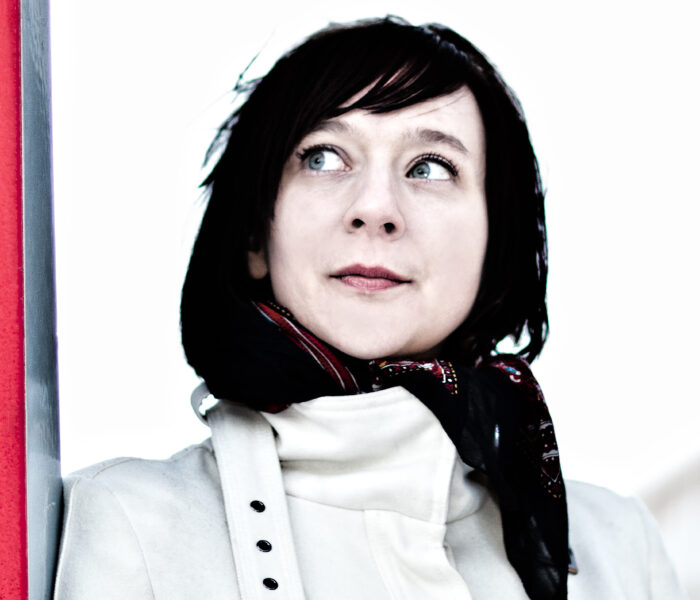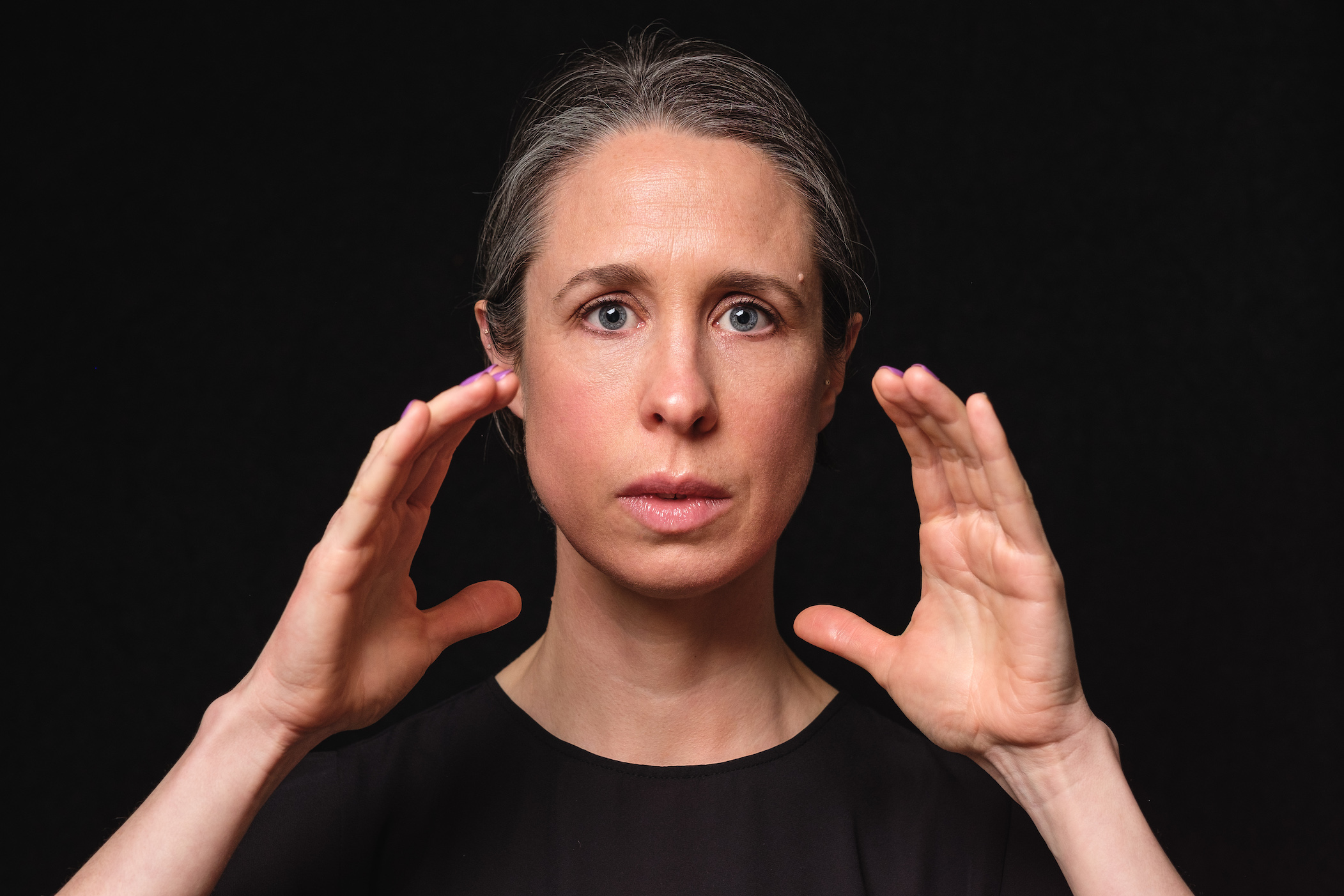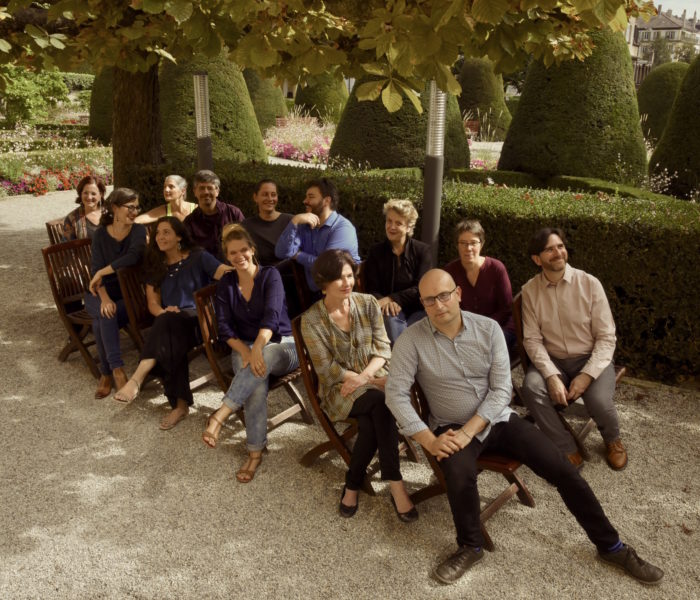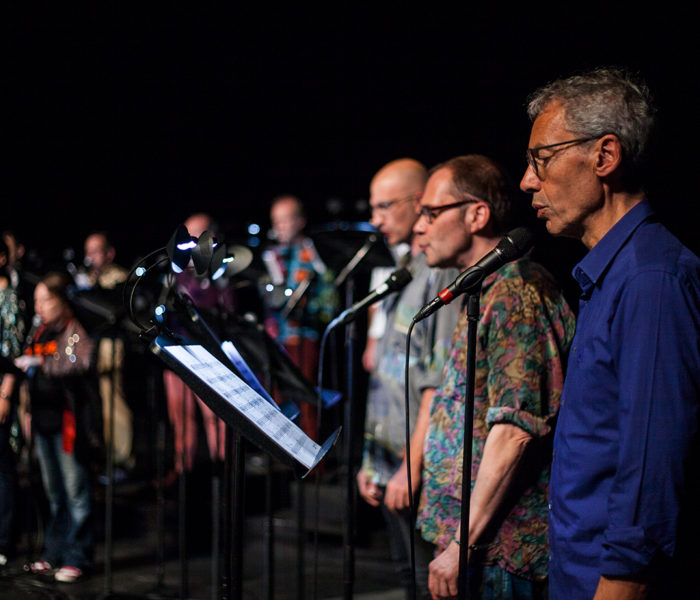When you've seen gambist, flautist and composer Eva Reiter on stage, you remember her commitment to musical gesture and thought. And this electroshock of perception is directly linked to the way she lives music, intensely.
When I think of you Eva, I immediately think of an incredible diversity of universes.
On the one hand, the viola da gamba and the recorder, which you first explored in early music; on the other, experimentation, within creative ensembles such as Ictus or Klangforum. On the one hand, too, a Eva Reiter interprets works, on the other an Eva Reiter composer. The "Darker than black" program you presented at the Royaumont Festival in 2022 with two other musicians from Ensemble Ictus, Theresa Dlouhy and Tom Pauwels, in which you played early English music as well as contemporary works and your own music, is a fine illustration of your work in rhizome.
How do you find your way through all this diversity? Where does the balance lie?
I don't know if we can speak of balance, but over the years it has become a kind of pendulum or spiral movement, which enables me - precisely through this diversity - to modify my artistic perspective over long and distinct periods.
Over time, I have also come to understand that the fields of my artistic activity do not oppose or cancel each other out, but on the contrary respond to and stimulate each other. My contact with compositional strategies gives me a different perspective on new works when I'm a performer. In fact, the same applies to my work as an interpreter of early music (Renaissance and Baroque): the study of the compositional strategies of this period and the forms of notations of the time have been very enriching.
In the same way, when I compose, I always take into consideration the logic of instrumental technique, the performative aspect, in the sense of a practice of execution (or interpretation); this means that I try out myself on the instrument each musical gesture introduced by the compositional idea, to make sure it's feasible.
I was trained as a gambist and flautist in my early years, it's true, but in parallel with this apprenticeship, I also studied piano, harpsichord, basso continuo, conducting and singing. The technical baggage I acquired as a blower and string player, added to my knowledge in other fields, proved to be a great help in approaching other instruments, when I was commissioned to write pieces for the most diverse formations.
Today I'm delighted not to have chosen one activity to the detriment of another. For well-defined periods of time, I adopt different perspectives, getting to the heart of things every time, and perhaps even more so than in the past. Composing is such solitary work! I soon felt the urge to get together with others in very different formations to make music, precisely to compensate for this solitude.
During my studies, this diversity of activities sometimes weighed on me. I had the feeling that I had to decide on a particular path, simply because I didn't have enough time. At the same time, I felt incapable of making such a decision.
Today, it has become much more natural to evolve in parallel in different musical disciplines. In the younger generation, there are countless musicians who are both composers and performers. I think this is right and proper! But when I was studying in Vienna and Amsterdam, there weren't many who tried to follow both voices in parallel.
This desire to accumulate knowledge and techniques came naturally to me: it was a way of freeing myself from a certain form of helplessness and dependence. It became increasingly vital for me as an artist not only to acquire knowledge as a performer, improviser (because I've done a lot of improvising) and composer, but also in the field of sound techniques, performance... All these roles are important, if you want to understand what music really is.
How did you come to compose your own music? Do you remember the initial impulse?
Before choosing to compose, I had spent a lot of time with a number of improvisation collectives in Vienna, Berlin, Amsterdam and London. These collaborations gave me the opportunity to work at a very young age - I wasn't even 20! - with musicians from very different worlds.
I played with musicians such as Franz Hautzinger, Burkhard Stangl, the Wandelweiser Group, Koen Nutters, Matthias Engler and Morton J. Olsen in Amsterdam, Christoph Kurzmann, Ken Vandermark, Martin Brandlmayer and Clayton Thomas, John Butcher, Chris Burn and a few others.
It was a great time in my life! I was really fascinated by the cognitive processes of collective decision-making, and also by the precision, speed and virtuosity of instantaneous work in the "real-time composition" proposed to several people. Sometimes the result was boring concerts, sometimes downright awful, but there were also moments of grace in this way of creating music collectively in the moment.
At a certain point, I felt the need to really formulate the musical processes and make artistic decisions in advance. I wanted to change the angle of view and explore a new world that we couldn't reach - it seemed to me - through improvisation.
Compositional ideas then became more and more concrete, so that I began to write sketches, which I enriched with all the material research accumulated during my long practice as an improviser.
I wanted to explore further and more diversely the fascinating processes of speed and virtuosity, the formal phenomena of compression and augmentation that I had approached in an ever-renewed way in the context of improvisation. For a long time, I put these works on the back burner, because I didn't trust myself enough. But one day, I dared to show my recorder teacher at the time , Walter van Hauwe , some of these scores. Not only did he encourage me to continue down this path, but he immediately put one of my compositions on the program of a conservatory concert. That's how it all began.
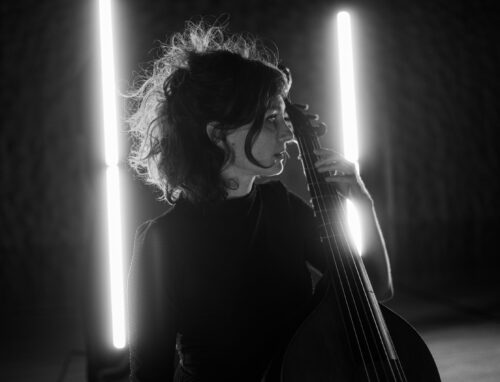
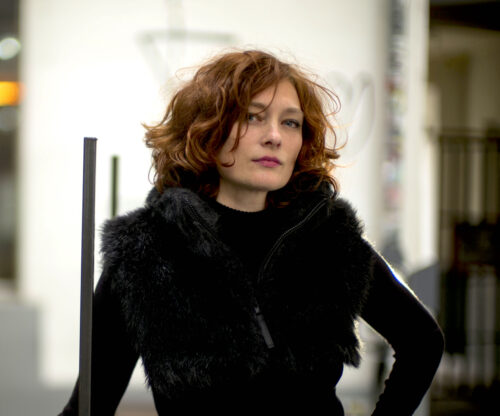
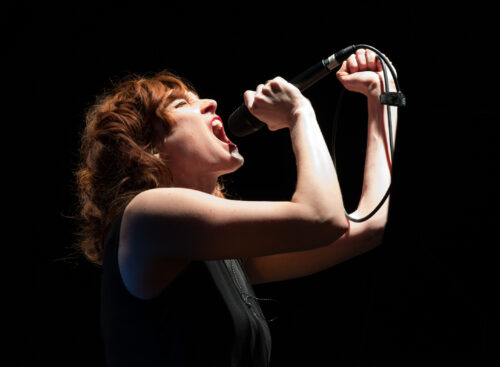
When I listen to your music, I'm always struck by the contrasting, powerful qualities of your world as a composer, a world where electronic sounds also have their place, as well as voice, breathing and words. I also feel an energy that in my mind is more related to pop or rock than to so-called contemporary music. Am I wrong?
Personal impressions are never wrong...
I'm one of those people who could be described as always restless, or to put it more positively, those people driven by a constant energy, a "drive". This is undoubtedly linked to a relative inability to protect myself from the excitements of the outside world, a form of hypersensitivity if you like. This fundamental state of acute perception of the world around me can be stressful, but it also has great advantages.
I was already very active as a child, creating everything from paintings and sculptures to music, because I realized early on that I could only find a certain inner peace in the creative process.
When I was a teenager, I found my soul brothers in bands like Pink Floyd, Aphex Twin, Metallica and Iron Maiden. I was consciously looking for the darker sides of these bands and of the world in general, like many kids my age, who basically had a comfortable, happy life. I was fascinated by the pressure, the intranquillity, the intoxication and the violence that these sounds exerted on me.
This is where the energy, the intranquillity, the strength that permeates my compositions comes from.
Electronic tools played an important role right from the start. When I started composing, my first idea was to use instrumental preparations to produce sounds with a raw, binary structure, sounds that you might have imagined had been produced by electronics. At the time, I was working mainly on everyday, city sounds: a cistern, the rustle of a ventilation duct, engine noises, printers, photocopiers, elevators and escalators. Nothing to do with my current work, which is much more pared-down and concentrated, but the pressure is still there!
In my artistic development over the years, aesthetic guidelines have gradually emerged: through them, I observe the world and try to offer an artistic reflection of it. But in doing so, I'm always guided by a form of inner resistance that I have to work on.
I'm insatiable: every day I want to discover new, totally unknown territories for which I don't have the modus operandi. I try to create spaces that are exploratory and in which it may be possible - or at least I hope so - to encounter the unpredictable.
How did you get into contemporary music? You started out playing early music, though...
Yes, my social identity as a musician-instrumentalist was mainly built up in the field of early music. My very first contact with the world of sound was through Renaissance and Baroque music, long before I came into contact with the world of contemporary music. My formative years in Vienna and Amsterdam - where I studied recorder and viola da gamba in the early music department - were nevertheless always imbued with a burning interest in the language of contemporary music. At that time, I came across a number of contemporary compositions for recorder - and much less unfortunately for viola da gamba - which unfortunately, in my eyes, were not of imperishable value. What's more, I had trouble finding the link between them. So I began to intensify my research, working with composers and composing myself. I was intensively exploring the rich sonic possibilities of the Paetzold flute, an instrument that has little to do with what one imagines when one thinks of the recorder family.
And as there was no catalog of contemporary playing techniques for the viola da gamba - in Austria, I was really the only one interested in it, and in Amsterdam I shared this interest with only one colleague - I began collaborating with cellists, so as to transpose existing techniques for this instrument to the viola da gamba, while adapting and developing them.
I understand that the sound universe of Fausto Romitelli has had an influence on your music. What other major influences have you had?
When I started exploring the richness of the Paetzold contrabass flute, of course I came across Fausto's piece Seascape composed in 1994. To this day, it remains for me the most interesting and innovative piece for this instrument. It opened up many new avenues for me. I spent hours, weeks and months exploring this composition. I was literally spellbound and fascinated by its richness and diversity of sound, by the compositional precision and heady musical gesture that inhabited the score. I recorded myself playing the piece, and sent the recording to Romitelli, who wrote back with great enthusiasm and encouragement. That letter, in a way, changed my life!
After that, his music became more and more present in my activities as a musician, as I discovered - and it was quite an experience - how he had found his own way within noisy, dystopian sound universes, and how he had detached himself from them in his own way. His penchant for the dark, murky side of our identity was familiar to me because of the quest that animated me, so his sound universe captivated me from the outset. We kept in touch, and I sent him a series of recordings of viola da gamba sounds. In 2004, Fausto Romitelli was commissioned by Wien Modern to create a work for electric guitar, viola da gamba and electronics, which kept us in touch for some time before he was tragically snatched from life at far too young an age.
In my career as a musician, there have been few sound experiences that have galvanized me to such an extent, made me euphoric with sound, and influenced me so much. I'll mention just a few, however: in my student days, a live performance of the Fantasies for viol consort by Purcell, a collaboration with the Wandelweiser collective, some pieces by Georges Aperghis, which fascinated me greatly, and the music of Fausto Romitelli, in particular An Index of Metallswhich I feel very close to.
In a way, these listening experiences encouraged me to follow my own path.
For me, composition has always been a way of proposing a utopia, a form of imaginary reality, an alternative scenario, which the listener can receive and let work within him or her. When, in the course of my work, I come up against an unfamiliar situation, it stimulates me more than it confuses me: I know then that I'm on the right track.
Sometimes you sing and use your voice. Do you see this practice as an extension of your instruments? Is it a way of introducing language and meaning, or just a way of breathing?
Of all the formal means at our disposal for giving shape to musical ideas, the world of vocal expression is the one that still holds the greatest fascination for me today. This is undoubtedly due to my first points of contact with music, namely the polyphonic language of the English and Italian Renaissance, and the unique aesthetics of Baroque music, a world I entered at an early age and which has fundamentally permeated my entire understanding of music. This music has left its mark on my entire development, particularly in terms of musical rhetoric and the detailed articulation of instrumental gesture. Very early on, I was taught to join my voice to the recorder and viola da gamba, so that it supported the textual intelligibility of the voices I was accompanying. And even when the piece I was playing wasn't vocal, I had to articulate my playing as if I were saying a text myself.
I've always found this very accurate. Even today, this idea plays a fundamental role in my understanding of contemporary musical languages. The vocal material is not only there as an extension of the instrument; it also offers the possibility of transposing instrumental articulation directly into speech, and vice versa.
This is what I did, for example, in Konter, by bringing the flute as close as possible to the megaphone and developing "orthographic" rules, so that the entire flute part takes the form of words, of sonorous syllables. Whatever I do, I always arrive at a way of phrasing that is inspired by human speech, its sonorities and melodic form.
In Noch sind wir ein Wort... und Wächter, the musicians are equipped with chromatically-tuned harmonic pipes that they can shake in the air, but into which they can also blow, speak, shout and sing.
In Lichtenberg Figuren, I use the voice in multiple variations and declensions, as a narrative vehicle, but also instrumentally, without the intervention of a signifier. What's more, thanks to the addition of effects, the voice is constantly modified: at times, it is so high that it becomes comical; at other times, on the contrary, it is much too low, and clashes with the image of the singer. This allows us to play with a wide range of possible identities.
At the moment, I'm working with Belgian choreographer Michiel Vandevelde on the creation of an experimental musical theater piece, The Rise. One of the play's protagonists is a young deaf man, Ruben Grandits, who is the only human able to communicate the story to the audience, despite his disability. He "speaks" to us in international sign language, and his signs are the point at which the world of sound and movement emerges. His movements are translated into language, and are the starting point for the instrumental line. Through the translation and recontextualization of gestures, symbols, signs and sounds, new languages are created that ultimately alter our understanding of a given world. For as soon as a message emerges that lies somewhere between sign language, sound, melody or movement, it acts as a delayed (slowed-down) echo, with an inevitable distortion of meaning.
For two years, thanks to the artistic research project Transforming Instrumental Gestures supported by the City of Vienna, I was able to develop and have built a series of new instruments whose primary aim is to transpose movement into sound.
As most of these instruments involve working together to produce the sounds, they also bring new forms of togetherness. For example, there's a 7-meter pipe monochord, an "Inside piano" on wheels, a giant pneumatic pump, 300 chromatic resonant tubes, a giant tuba-octopus that extends into the audience, a reactive sound floor that doubles as a wall and table, suspended metal plates, homemade trumpets and a host of sound boxes.
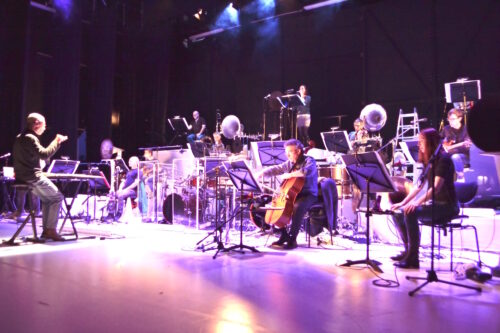
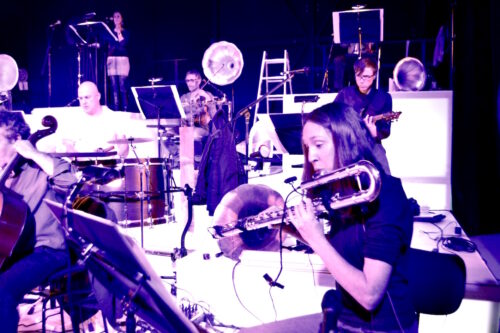
Can you tell me in a few words what your day-to-day work consists of, as you spend your time experimenting on different levels: playing techniques, preparation, combining with electronic devices, designing new instruments?
I'd like to quote the sociologist Antoine Hennion : " To get to the heart of things, you have to stay on their surface". This maxim is central to my artistic work.
When I start work on a new piece, all my attention is focused for weeks, even months, on the instrumentarium, which I sometimes build myself. I experiment with sounds, retaining certain discoveries, abandoning others: more and more, I realize that this slow, direct contact with sound sources through improvisation opens up new avenues for me. My dual training as a "blower" and string player naturally helps, as I've accumulated a lot of physical reflexes on many instruments. Learning the technique of an instrument, getting to grips with its surface, then allows me to enter into the material of sound.
You play in the ensemble Ictus since 2015. What does this ensemble mean to you? I understand you also have artistic responsibility in the ensemble?
My collaboration with guitarist Tom Pauwells of the Ictus ensemble dates back to the time when Wien Modern commissioned Fausto Romitelli, as I mentioned earlier (2004), and which unfortunately never materialized. Nonetheless, it gave me the opportunity to meet Tom, as we both took part in the tribute concert for Fausto organized at the Vienna Konzerthaus: together we created a duet by Paolo Pacchini and played Trash TV Trance and Seascape. This tribute concert in memory of Romitelli was the starting point for a long collaboration with Tom, in duo, trio and with Ictus. For almost twenty years, working with Tom has been a constant in my life as a musician. There's a kind of obviousness and deep connivance in our shared history.
The Ictus ensemble, of which Tom has been a member for many years, first invited me to take part in several concerts, including the Liquid-Room. I then composed two pieces for them. Finally, they asked me to join the ensemble and act as artistic advisor on their projects. Since then, I've been behind several of the ensemble's programs, including Darker than black, The Lichtenberg Figures, Eupepsia-Dyspepsia and Le Retour. I'm currently working with them on The Rise, which will be premiered by Ictus at the Manifeste festival at the Centre Pompidou in June 2024.
Ictus is my musical family. We've been working together for so long! Collaborating with Ictus means sharing our visions and insights with great enthusiasm, pleasure and joy. It also means a great deal of confidence in the future, on an artistic level, not to mention the friendship and deep trust that binds us together.
Were you born into a musical family?
How did your first love for early music, the viol and the recorder come about?
I was born into a family that attached great importance to music without anyone playing it. In retrospect, I think this was an advantage for me because music was my territory, even if for a very long time I thought I'd be more of a visual artist. But my parents were alerted to my gifts by my music teacher and supported me in this direction. My recorder teacher opened me up to the fascinating world of early music, which led me to take up the viola da gamba and vocal polyphony. My taste for exploration was born at this point. Luckily, my parents never forced me to do anything, otherwise I might have lost my taste for music. Music blossomed slowly within me, without pressure or demands.
Interview by Anne Montaron
Photos © nafezrerhuf.com
Photos © Daniel Dittus
Photos © Petra basche/HuPe-kollektiv
Photos © Ictus



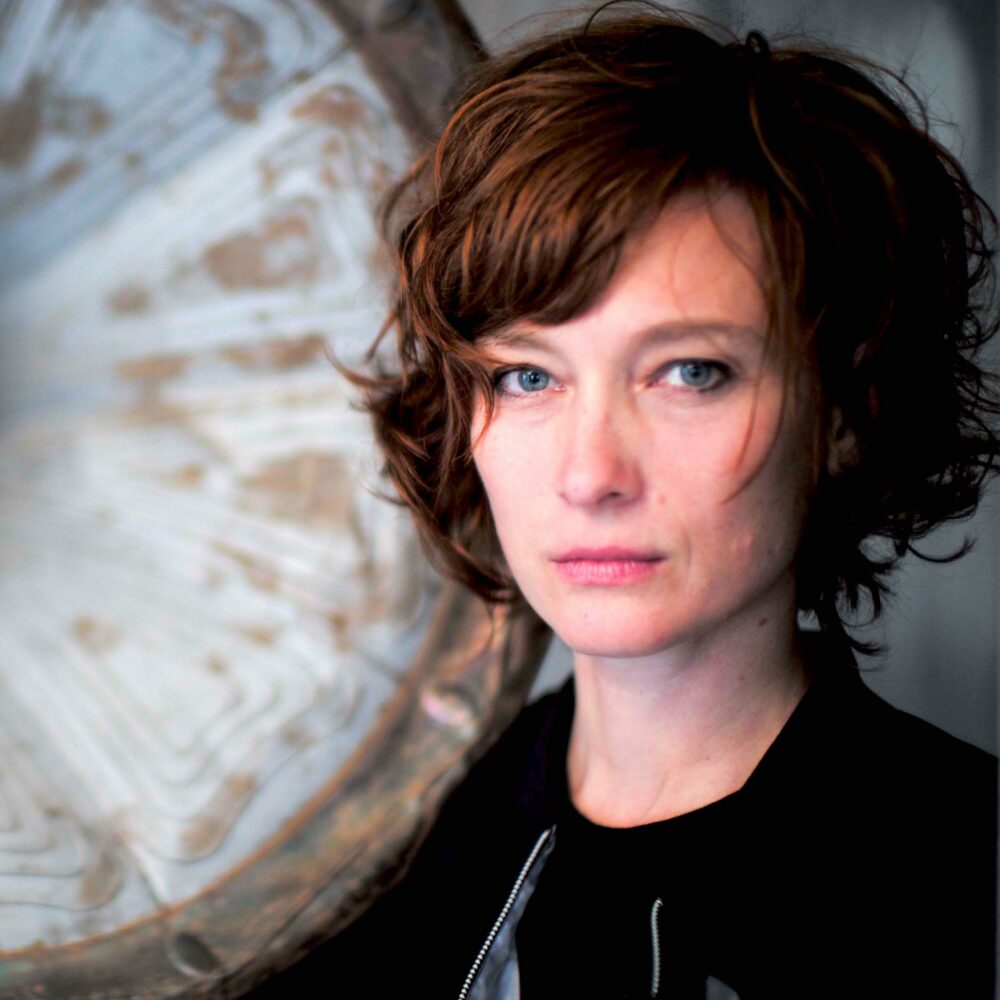)
